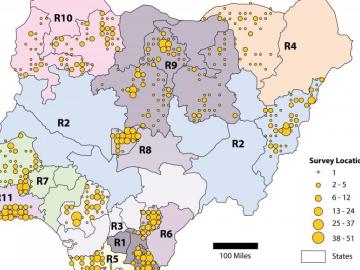Filter News
Area of Research
- (-) Energy Sciences (2)
- (-) National Security (8)
- (-) Neutron Data Analysis and Visualization (2)
- (-) Nuclear Science and Technology (18)
- Advanced Manufacturing (15)
- Biological Systems (2)
- Biology and Environment (32)
- Building Technologies (7)
- Chemical and Engineering Materials (1)
- Clean Energy (152)
- Climate and Environmental Systems (4)
- Computational Biology (1)
- Computational Engineering (2)
- Computer Science (10)
- Electricity and Smart Grid (1)
- Fossil Energy (1)
- Fusion and Fission (4)
- Fusion Energy (8)
- Isotope Development and Production (1)
- Isotopes (5)
- Materials (75)
- Materials for Computing (10)
- Mathematics (1)
- Neutron Science (35)
- Nuclear Systems Modeling, Simulation and Validation (2)
- Quantum information Science (3)
- Renewable Energy (2)
- Sensors and Controls (2)
- Supercomputing (41)
- Transportation Systems (2)
News Type
News Topics
- Advanced Reactors (4)
- Big Data (2)
- Biomedical (1)
- Computer Science (2)
- Coronavirus (1)
- Cybersecurity (1)
- Energy Storage (2)
- Environment (1)
- Fusion (1)
- Grid (2)
- Isotopes (1)
- Molten Salt (3)
- Neutron Science (2)
- Nuclear Energy (10)
- Security (1)
- Space Exploration (2)
- Summit (1)
- Sustainable Energy (2)
- Transportation (1)
Media Contacts

ORNL researchers, in collaboration with Enginuity Power Systems, demonstrated that a micro combined heat and power prototype, or mCHP, with a piston engine can achieve an overall energy efficiency greater than 93%.

Oak Ridge National Laboratory researchers have created a technology that more realistically emulates user activities to improve cyber testbeds and ultimately prevent cyberattacks.

Oak Ridge National Laboratory researchers proved that the heat transport ability of lithium-ion battery cathodes is much lower than previously determined, a finding that could help explain barriers to increasing energy storage capacity and boosting performance.

Oak Ridge National Laboratory scientists helped count the population of Nigeria – all without leaving the lab.

A developing method to gauge the occurrence of a nuclear reactor anomaly has the potential to save millions of dollars.

Oak Ridge National Laboratory researchers have discovered a better way to separate actinium-227, a rare isotope essential for an FDA-approved cancer treatment.

Oak Ridge National Laboratory’s high-resolution population distribution database, LandScan USA, became permanently available to researchers in time to aid the response to the novel coronavirus pandemic.

In the 1960s, Oak Ridge National Laboratory's four-year Molten Salt Reactor Experiment tested the viability of liquid fuel reactors for commercial power generation. Results from that historic experiment recently became the basis for the first-ever molten salt reactor benchmark.

Oak Ridge National Laboratory researchers working on neutron imaging capabilities for nuclear materials have developed a process for seeing the inside of uranium particles – without cutting them open.

A novel approach developed by scientists at ORNL can scan massive datasets of large-scale satellite images to more accurately map infrastructure – such as buildings and roads – in hours versus days.




